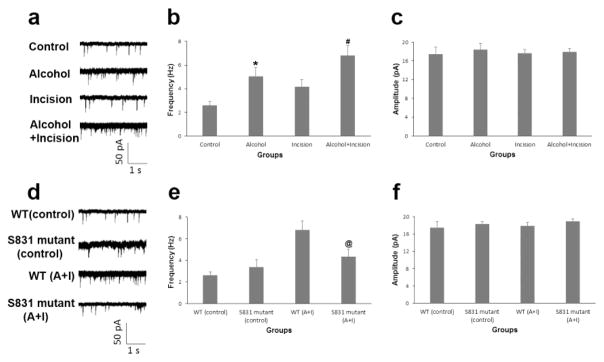Figure 4.
Chronic alcohol consumption increases AMPA receptor-mediated synaptic activities via the regulation of GluA1 Ser831 phosphorylation in the spinal dorsal horn neurons (n = 16 for control group, n = 13 for alcohol group, n = 14 for incision group, and n = 13 for alcohol plus incision group in a, b and c; n = 16 for WT control group, n = 11 for S831 mutant control group, n = 13 for WT alcohol plus incision (A+I) group, and n = 12 for S831 mutant A+I group in d, e and f). a On day 15 after incision and/or ethanol treatment, chronic alcohol consumption not only increased the frequency of AMPA receptor-mediated mEPSCs in the spinal cord neurons (Alcohol group), but also further enhanced incision-induced spinal AMPA receptor-mediated electrical activities (Alcohol+Incision group). b Statistical analysis of the data in a. *P < 0.05 vs. control group; #P < 0.05 vs. incision group. c None of these treatments had significant effect on the current peak amplitude. d AMPA receptor GluA1 Ser831 phospho-deficient mutant mice showed similar basal currents as those in WT mice under normal conditions, but the GluA1 S831A mutation significantly diminished the chronic alcohol consumption-produced increase in the spinal AMPA receptor-mediated mEPSCs. e Statistical analysis of the data in d. @P < 0.05 vs. WT mice. f There was no significant change in the current amplitude after these treatments in the GluA1 S831A phospho-deficient mutant mice.

